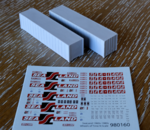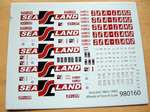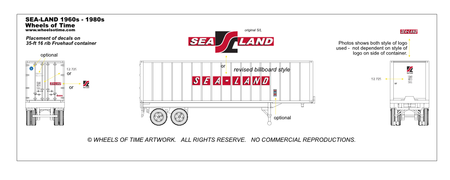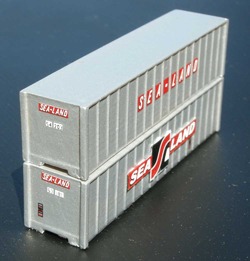Wheels of Time Custom Editions N Scale
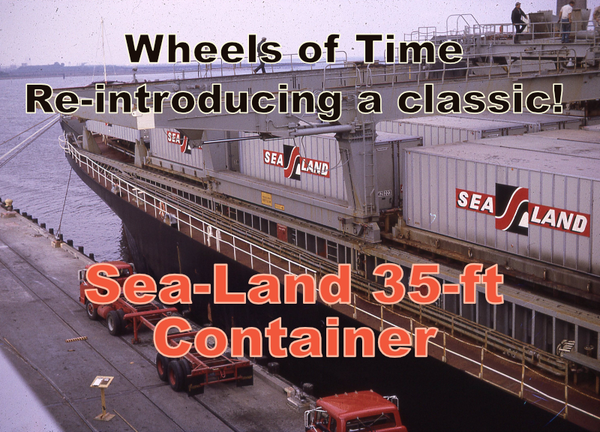
December 2022: Limited Stock. Please see below.
Get the Sea-Land Brochure PDF PNG
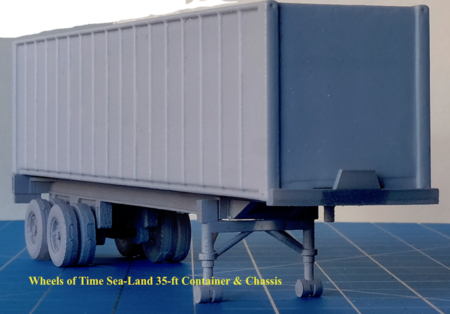 WOT Sea-Land Container & Chassis
WOT Sea-Land Container & Chassis
Wheels of Time HO scale Sea-Land Containers & Chassis
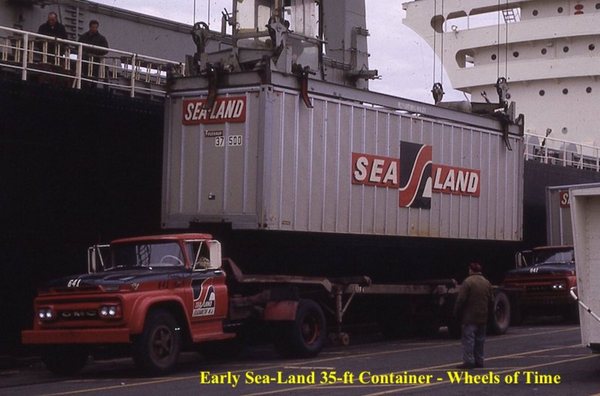
The Sea-Land Years
Malcom McLean of McLean Trucking Company started to experiment with a detachable truck trailer which could be transported on sea and land eliminating multiple loading and unloading of goods. This process eliminated the damage and pilferage providing a safer and more reliable door to door movement of cargo. He founded Sea-Land Service, one of the pioneers in containerized freight.
McLean had experienced frustrating delays waiting for the longshoremen to transfer his cargo from trucks to ships. He decided to change the way cargo was handled. In 1955, McLean purchased the Waterman Steamship Corp. which instantly gave him a fleet of 37 Type C-2 dry cargo vessels (similar to the WW2 "Victory Ships") - about third of the U.S. Flag cargo fleet at that time. On April 26 1956, Ideal-X, a converted Type T2, a former tanker built by Marinship at Sausalito in 1945, Ideal-X carried fifty-eight 35-ft containers (8-ft high by 8-ft wide) as well as a load of bulk oil and sailed from the Port of Newark, New Jersey to the Port of Houston, Texas. The trailers were lifted on board with their running gear left on the pier, essentially becoming a container. It costed about $5.83 per ton to load a medium-size cargo ship, while the Ideal-X was loaded at less than $0.16 per ton. McLean was on to something that would revolutionize the way cargo was handled between different modes of transportation. (The 35-ft size was the legal length limit on U.S. highways at that time.) In 1957, "Gateway City", a Type C-2 dry cargo vessel was thoroughly rebuilt so containers were loaded into the "holds" and stacked atop of each other, thus increasing capacity to 226 35-ft units. By 1959, McLean was offering "trailer" service to the ports of Newark to Houston, Puerto Rico, San Juan, Jacksonville, and Miami.
In 1960, McLean renamed his Pan-Atlantic Steamship Corporation to Sea-Land Service, Inc., and began additional service to Long Beach and Oakland, California when most intracontinental merchant shipper were loosing ground. By the end of 1966, Sea-Land operated a fleet of more than 12,500 trailers and regularly sailed from Elizabeth (NJ) and Baltimore to Europe. In 1969, R.J. Reynolds acquired Sea-Land for infusion of capital in the shipping giant. In 1972, Sea-Land and railroads provided coordinated container services for seamless transportation from port to port. By 1974, conventional bulk cargo ship companies Moore-McCormack, Delta-Lines and Prudential-Grace saw their slide of market share due to the efficient Sea-Land operation with Latin American. They invoked legislation in South American and outlawed non-ISO 35-ft containers. In response, Sea-Land introduced their 40-ft container with about 1600 units from Gindy numbered 100001 to 101669. To make their 35-ft and 40-ft container be stackable together, they developed the double corner posts, a Sea-Land patented feature. Interestingly, Sea-Land continued to purchase 35-ft containers through 1982. In 1984, Sea-Land emerges from R.J. Reynolds control as an independent company. In 1986, CSX subsidiary CSA Acquisition Corp. acquired Sea-Land for $800 million. With CSX refocusing it's efforts on their railroad business and in an effort to raise capital after their purchase of Conrail, they spun off Sea-Land international service to Maersk (1999), their domestic line to the Carlisle Group as Horizon Lines (2003) and the port operator as CSX World Terminals.
A great fun read, if you want to learn more about the history of containerization in general, is "The Box" by Marc Levinson. Mr. Levinson explains how the shipping container made the world smaller and the world economy bigger.
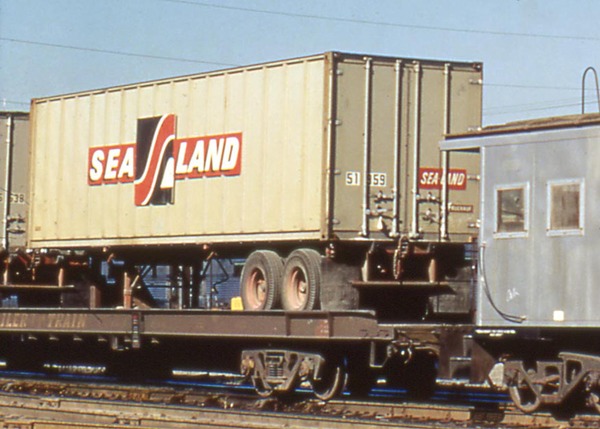 35-ft Sea-Land 16 Rib Fruehauf on chassis
35-ft Sea-Land 16 Rib Fruehauf on chassis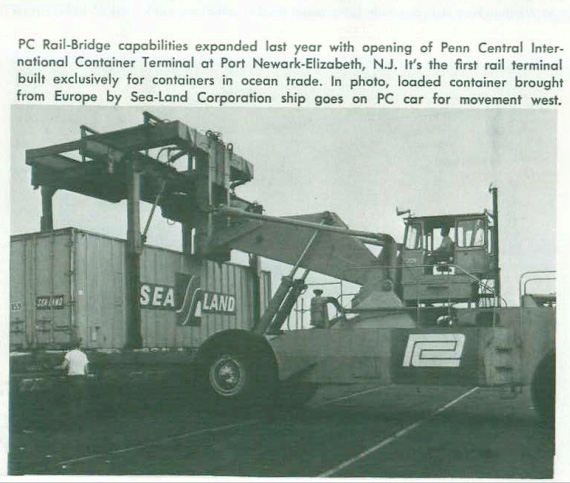 From Penn Central Magazine
From Penn Central Magazine
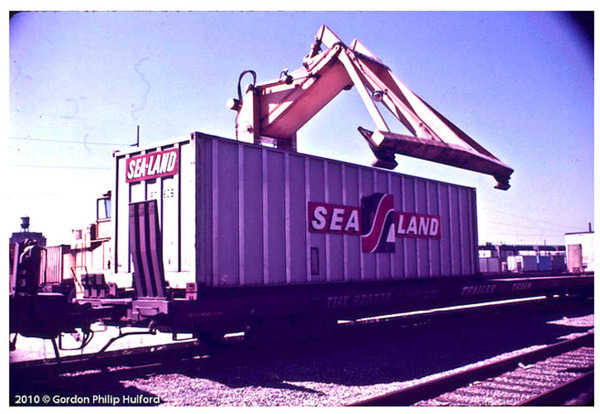
Sea-Land, Trains and Ports
In the 1960s, McLean approached the Pennsylvania Railroad to carry it's containers from East Coast ports to the mid-west, and was subsequently turned down initially when they became Penn-Central. McLean had to wait before he saw his containers truly traveled intermodally. In 1972, Sea-Land started offering coordinated "Land-Bridge" service with railroads from coast to coast eliminating the need to detour through the Panama Canal and thus saving about 10 days in transit time. For instance, a ship from Asia would transfer it's containers at Long Beach (CA), to a connecting train headed for the New York area. This coordinated railroad Land-Bridge service provided seamless transit from Asia to the East Coast, Asia to the Gulf Coast, Europe to the West Coast; and as well as mini Land-Bridge service from coastal ports to mid-America. (K-Line, Matson, and Seatrains were the other early adopters of the railroad coordinated Land-Bridge business.)
A snap shot in 1979 of major U.S. Sea-Land ports of call (not a complete list) with coordinated railroad service:
Boston/Conrail/Europe - feeder service;
Elizabeth Port Authority Marine Teminal NJ/Conrail/Europe;
Baltimore/Chessie/Europe;
Philadelphia/Conrail - feeder service;
Portmouth Marine Terminal VA/Cheesie/N&W;
Jacksonville FL/SCL; Charleston SC/SOU;
New Orleans/NOPB? /ICG/L&N/SP/SCL/Carribean and Latin America;
Houston/ATSF/MP/SP;
Long Beach (Berths 227, 228, Pier G/ATSF, SP, UP/Asia;
Oakland/SP/WP/Asia;
Seattle/BN/MILW/UP/Asia.
Northern Pacific's South Seattle Intermodal yard was handling 150 containers a month in 1969 including Sea-Land. By 1972, BN's former NP South Seattle intermodal yard was handling 1500 containers a month. Conrail (1978) handled 55,000 Land-Bridge traffic from Asia via Seattle, Oakland and LA to their eastern seaboard.
Sea-Land Logos
Sea-Land initial logo was a circle emblem on a sheet metal disc flanked by italic SEA-LAND SERVICE.
Sometime in the mid-1960s, they revised their logo with large san serif italic SEA LAND with a stylized SL logo, all on sheet metal panels. This was applied on their containers even into 1969 or 1970. However, the sheet metal panels were easily damaged and then were replaced by individual letters on each sides. This SEA-LAND billboard style became the new look. Sometime in the 1990s, perhaps with the merged into CSX, Sea-Land font styled changed and with S/L logo on the flanks of the containers.
Wheels of Time decals covers 35-ft and 40-ft dry vans during the S/L and SEALAND billboard style during the 1960s to 1980s. The decals have the both styles of Sea-Land including 'ACI Labels" and the round blue & white American Bureau of Shipping logo which seemed to be placed sometime during the 1970s. These decals are first ever made for this period of time. They are thin filmed water slide decal with "film" on only on decorated lettering & numbering, so there is no need to cut out each individual marking.
Sea-Land Containers (Background)
In 1972, Sea-Land container fleet was as follows according to Jane's Freight Container:
36,500 dry vans 35 x 8 x 8.5; 1,850 dry van 40 x 8 x 8.5; 1280 insulated van 35 x 8 x 8.5; 5410 refrigerated 35 x 8 x 8.5; 600 tank 35 x 8 x 4.25; 1,700 open top 35 x 8 x 8.5; 450 flat bed 35 x 8 x 8.5; 200 cartainer 35 x 8 x 5.1; 150 cartainer 35 x 8 x 6.7; 1 cattlecar 35 x 8 x 10.2
Well known builders such as Fruehauf, Trailmobile, and Gindy constructed Sea-Land containers.
Sea-Land 35-ft dry containers had a capacity of 2099 to 2195 cu ft while their 40-ft dry containers were 2704 cu ft.
35-ft dry containers were numbered from 30000 to 74451 (not inclusive). Confusingly in 1970, some and not all newly constructed containers began showing up "SEAU" and the 6-digit ISO numbering. 300000-series were 35-ft, 100000-series were mainly 40-ft, 150000-series were 40-ft high cube wth 35-ft stacking post. Previously constructed containers were apparently never renumbered to 6-digit seriies. Pre-ISO containers (1960s) were numbered initially with 4 digits and then with 5 digits.

